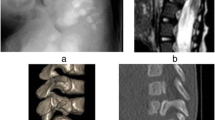Abstract
Background
Split cord malformation (SCM) is a rare congenital malformation of the spinal cord in which the cord is split longitudinally. Identification and diagnosis in adulthood is rare, with the majority of cases diagnosed in the paediatric population. Isolated segmental cervical SCM is rarer still.
Case presentation
Here, the authors present the case of a 26-year-old female who presented with neck pain and longstanding bimanual synkinesis secondary to an isolated type II SCM in the C4–C7 region. The authors present this novel presenting symptom in adulthood and finding of isolated cervical SCM with associated blocked cervical vertebrae, in an otherwise normal neuroaxis and spinal column.
Conclusions
The case serves to highlight the importance of knowledge of this rare congenital condition to surgeons, physicians and radiologists involved in the care of both adult and paediatric patients presenting with spinal pathology.

Similar content being viewed by others
References
Hamidi H, Foladi N (2019) Misdiagnosed adult presentation of diastematomyelia and tethered cord. Radiol case reports 14:1123–1126. https://doi.org/10.1016/j.radcr.2019.06.025
Bekki H, Morishita Y, Kawano O et al (2015) Diastematomyelia: a surgical case with long-term follow-up. Asian Spine J 9:99–102. https://doi.org/10.4184/asj.2015.9.1.99
Srinivasan ES, Mehta VA, Smith GC et al (2020) Klippel–Feil syndrome with cervical diastematomyelia in an adult with extensive cervicothoracic fusions: case report and review of the literature. World Neurosurg 139:274–280. https://doi.org/10.1016/j.wneu.2020.04.148
Adelson PD (2014) Diastematomyelia. In: Encyclopedia of the neurological sciences. Academic Press, pp 996–997
Rossi A, Biancheri R, Cama A et al (2004) Imaging in spine and spinal cord malformations. Eur J Radiol 50:177–200. https://doi.org/10.1016/J.EJRAD.2003.10.015
Cheng B, Li FT, Lin L (2012) Diastematomyelia. J Bone Joint Surg Br 94-B:365–372. https://doi.org/10.1302/0301-620X.94B3.27897
Dickerman RD, Colle KO, Mittler MA (2004) Intramedullary inflammatory mass dorsal to the Klippel–Feil deformity: error in development or response to an abnormal motion segment? Spinal Cord 42:720–722. https://doi.org/10.1038/sj.sc.3101645
David KM, Copp AJ, Stevens JM et al (1996) Split cervical spinal cord with Klippel–Feil syndrome: seven cases. Brain 119:1859–1872. https://doi.org/10.1093/brain/119.6.1859
Hudson EW, Makis W (2016) Klippel–Feil syndrome with spinal dysraphism: Diastematomyelia on 18F-NaF Bone PET, CT, and MRI imaging. Clin Nucl Med 41:405–406. https://doi.org/10.1097/RLU.0000000000001123
Lopez-Vicchi M, Da Prat G, Gatto EM (2015) Pseudodystonic posture secondary to Klippel–Feil syndrome and Diastematomyelia. Tremor and Other Hyperkinetic Movements 5:325. https://doi.org/10.5334/tohm.276
Bae Y (2014) Effects of cervical deep muscle strengthening in a neck pain: a patient with Klippel–Feil syndrome. J Phys Ther Sci 26:1999–2001. https://doi.org/10.1589/jpts.26.1999
Mahapatra AK (2011) Split cord malformation—a study of 300 cases at AIIMS 1990–2006. J Pediatr Neurosci 6:S41–S45. https://doi.org/10.4103/1817-1745.85708
Korinth MC, Kapser A, Nolte K, Gilsbach JM (2004) Cervical diastematomyelia associated with an intradural epidermoid cyst between the hemicords and multiple vertebral body anomalies. Pediatr Neurosurg 40:253–256. https://doi.org/10.1159/000082303
Balci S, Oguz KK, Firat MM, Boduroglu K (2002) Cervical diastematomyelia in cervico-oculo-acoustic (Wildervanck) syndrome: MRI findings. Clin Dysmorphol 11:125–128. https://doi.org/10.1097/00019605-200204000-00010
Acknowledgements
The authors would like to acknowledge the patient for providing fully informed consent for this case report.
Author information
Authors and Affiliations
Corresponding author
Ethics declarations
Conflict of interest
The authors declare no conflicts of interest. No funding was received for this article.
Additional information
Publisher's Note
Springer Nature remains neutral with regard to jurisdictional claims in published maps and institutional affiliations.
Rights and permissions
Springer Nature or its licensor (e.g. a society or other partner) holds exclusive rights to this article under a publishing agreement with the author(s) or other rightsholder(s); author self-archiving of the accepted manuscript version of this article is solely governed by the terms of such publishing agreement and applicable law.
About this article
Cite this article
Goacher, E., Lee, C. Cervical split cord malformation (diastematomyelia) with associated Klippel–Feil deformity presenting in adulthood with bimanual synkinesis. Eur Spine J (2024). https://doi.org/10.1007/s00586-023-08068-7
Received:
Revised:
Accepted:
Published:
DOI: https://doi.org/10.1007/s00586-023-08068-7




